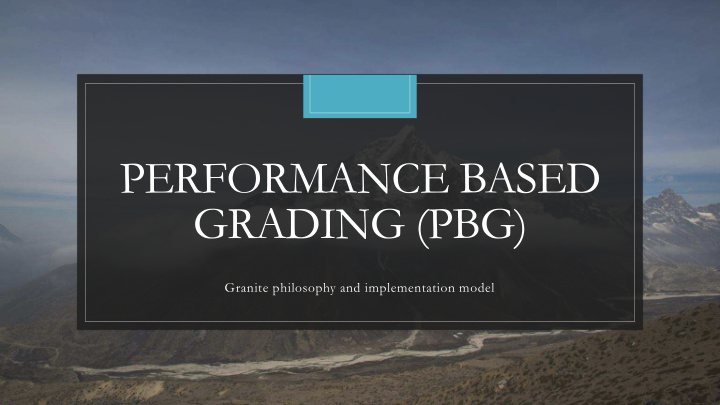



PERFORMANCE BASED GRADING (PBG) Granite philosophy and implementation model
Philosophy ◦ PBG makes learning transparent ◦ PBG focuses learning ◦ PBG is student-centered ◦ PBG is based on the Utah State Core Curriculum Standards that have been established for all classes ◦ PBG is a proficiency-based system ◦ PBG is empowering for students
Philosophy, cont. Student proficiency is built through learning activities, and homework is an important learning activity Student proficiency is determined through assessments Assessments are the only things that impact a student’s academic grade Student learning is the focus, and, as such, assessments can be retaken
Changing Thinking about Grades ◦ PBG is a student-centered grading system ◦ Under a traditional grading system, students are “Marked down” when they don’t know something ◦ This is a negative grading approach wherein teachers are looking for student mistakes ◦ Under PBG grading, students are given the opportunity to “Show what they know” ◦ This is a positive grading approach wherein teachers are looking to see how much students know, and students know the emphasis is on showing what they have learned as opposed to fearing what they haven’t
Implementation ◦ Teachers can and will assign learning activities (homework) as needed to help students learn and build skills needed to become proficient in the learning required of each standard that is taught ◦ Learning activities will be focused and tied directly to required student learning for a standard ◦ Learning activities will be used and reviewed in class, but they will not be graded and added to a PBG grade ◦ Teachers will assess student learning for each standard that is taught, and the assessments will constitute a student’s PBG grade ◦ Students will have the opportunity to re-do assessments if/when they feel they have improved their learning on a standard and can improve their score on the assessment ◦ Teachers can require students to complete incomplete learning activities, and/or show that they have reviewed their learning on a standard prior to having a student re-do an assessment
Implementation-Grades ◦ Assessments will be scored on a scale of 1-4. ◦ 1-Below Proficient ◦ 2-Approaching Proficient ◦ 3-Proficient ◦ 4-Above Proficient ◦ A standard will have to have three assessments to calculate into the final score/grade for a class ◦ The calculated grade for an assessment will be done via a decaying average ◦ First assessment-12% ◦ Second assessment-23% ◦ Third assessment-65% ◦ Additional assessments affect the % value of the first assessment, the final assessment is always worth 65% ◦ Not all standards that are assessed have to be assessed three times ◦ Not all standards have to be assessed
Implementation-Grades, cont. ◦ 7 th and 8 th graders will only receive PBG grades ◦ PBG grades will not be converted to a letter grade ◦ The focus is on proficiency and improving proficiency (learning) ◦ Emphasis is not on grade getting ◦ 7 th and 8 th grade students in high school credit classes will have their PBG grade converted to a letter grade ◦ Foreign language classes ◦ Advanced math classes ◦ 9 th graders will receive PBG grades and a letter grade ◦ There is an established, district-wide conversion table that was posted in the letter sent home ◦ For 9 th grade teachers only, PBG is optional this year ◦ Some teachers are doing it, some are not. ◦ This may cause some confusion as students will be flowing between two grading philosophies ◦ We will help them, and you, navigate this
How is PBG Grading Student-Centered? ◦ Students will know the standards they are learning ◦ Students will know the learning required by the standard ◦ Students will know how proficiency will be determined for each standard ◦ Students will know how assessments will be scored for proficiency ◦ Students have the ability to re-do assessments to show their improved proficiency
Additional thoughts ◦ The faculty sees the value in a student-centered, empowering grading system that allows them to take more control of their learning with the guidance of teachers ◦ The decaying average is a good system for grading as it de-emphasizes early assessments that take place as students are building their knowledge and places greater impact on the final assessment that should be taken place once learning is complete and students feel confident in their proficiency ◦ Implementation of advisory this year is a direct result of implementation of PBG and teachers wanting to have an avenue for working with students in the PBG model ◦ The faculty is committed to implementing PBG with fidelity to the philosophy and grading system established by the district ◦ Teachers are not handcuffed in the PBG model; they still teach the class, create learning activities and assessments, and work with students
Recommend
More recommend